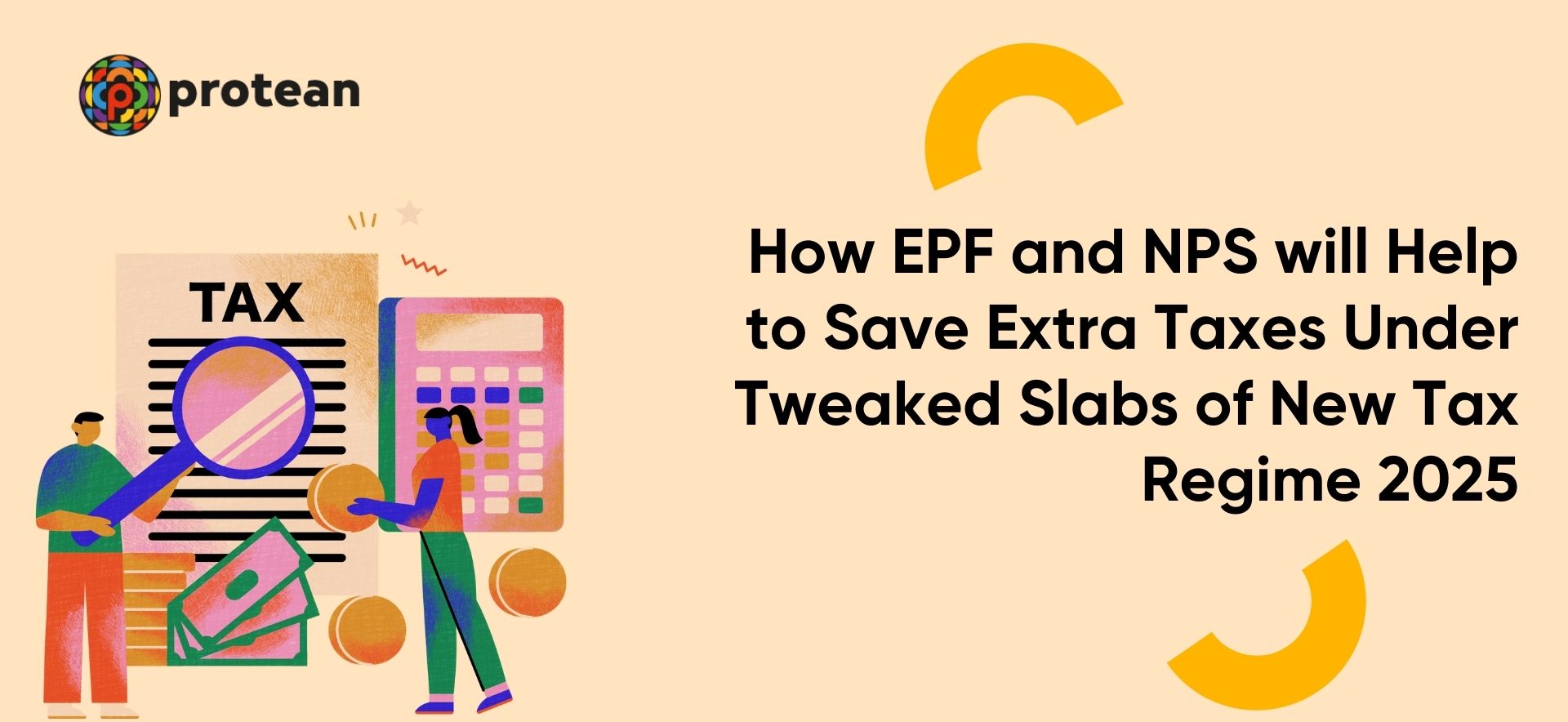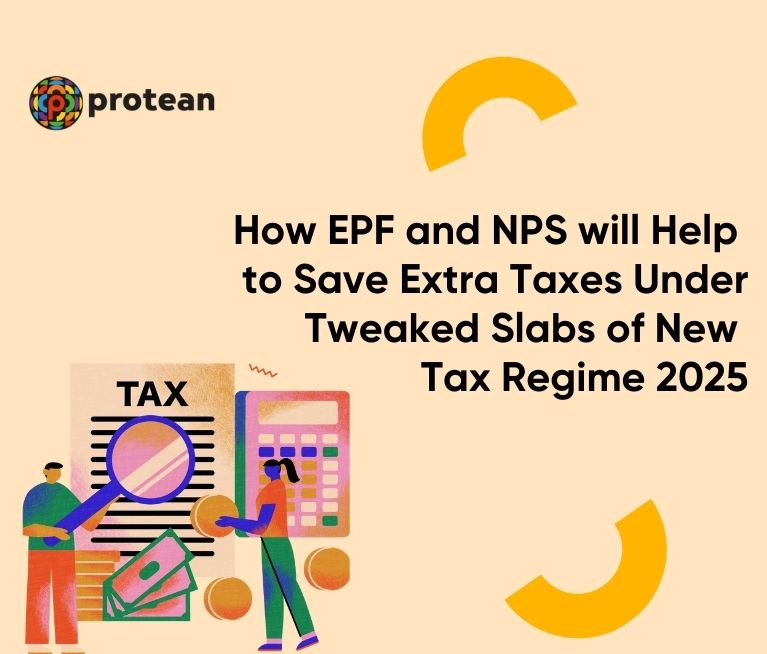The Union Budget 2025 has introduced several pivotal reforms that could significantly benefit salaried individuals across the country. By revising tax slabs and enhancing savings schemes like the Employees’ Provident Fund (EPF) and the National Pension System (NPS), the government aims to make financial planning easier and more rewarding.
These adjustments are not just numbers on paper—they represent tangible opportunities for individuals to retain more of their hard-earned income. In this article, we'll break down the EPF and NPS news and the major changes and show how they can help you save more and plan better for your future.
Revised Tax Slabs and Rebate Limits
The government made important changes to income tax in Budget 2025. One big change is increasing the amount of money people can earn before paying tax, called the rebate limit. Before, people did not have to pay tax if they earned ₹7 lakh or less per year. Now, people can earn up to ₹12 lakh per year without paying tax.
People who earn ₹12 lakh or less get a standard deduction of ₹75,000 and a tax rebate of ₹60,000. So they will not owe any income tax. This change helps the middle class and people with higher salaries. It lets them keep more of the money they earn instead of paying tax.
Overall, increasing the tax rebate limit to ₹12 lakh per year is good for many people. More people will be exempt from paying income tax now, which puts more money in the hands of the middle class. The government made this change to relieve taxpayers.
| Also Read: NPS Tax Benefits Guide |
Comparison of Key Tax Benefits (NPS vs EPF)
| Feature | National Pension System (NPS) | Employees' Provident Fund (EPF) |
| Tax-Free Annual Income Limit | ₹13.7 lakh | ₹12 lakh |
| Standard Deduction | ₹75,000 | ₹75,000 |
| Employer Contribution Limit | Up to 14% of basic salary (tax-deductible) | Up to 12% of salary (tax-exempt) |
| Employee Contribution Deduction | Not deductible under the New Regime | Not deductible under the New Regime |
| Interest Rate | Market-linked returns | Fixed-rate of 8.25% |
| Management Fees | 0.09% per year | Not applicable |
| Flexibility | High (asset allocation, fund switching) | Low (fixed contributions and returns) |
| Withdrawal Taxation | Taxable on withdrawal | Exempt under certain conditions |
National Pension System (NPS) – Enhanced Benefits
The NPS is a retirement savings national pension scheme that has become more beneficial due to recent budget changes. Now, people with salaries can earn up to ₹13.7 lakh per year tax-free. This is higher than the normal ₹12 lakh limit. The extra tax savings come from the ₹75,000 standard deduction and NPS investments.
The NPS usually offers good tax advantages compared to other savings plans, especially under the New Tax Regime. In the 2024 budget, Section 80CCD(2) was introduced. This lets salaried employees invest 14% of their basic salary in the NPS tax-free, up from 10%.
Overall, the latest budget made the NPS more tax-friendly for salaried individuals. Between the standard deduction and higher NPS investment limits, people can earn up to ₹13.7 lakh per year tax-free. This makes the NPS a preferred retirement savings option for many salaried taxpayers looking to maximize savings. The changes make the NPS offer even better tax benefits than before.
| Also Read: NPS Contributions with Instant NAV |
Key Highlights of NPS Benefits
Here are key highlights of the NPS benefits:
1. Higher Tax-Free Income Limit
People with salaries can now earn ₹13.7 lakh per year without paying any income tax. This is higher than the normal ₹12 lakh tax-free limit. The extra ₹1.7 lakh of tax savings comes from the standard deduction and NPS investments.
2. Increased Employer Contribution Deduction
Employers can contribute up to 14% of an employee's basic salary to the NPS on their behalf. The entire 14% contribution qualifies for tax deduction. Previously, only 10% of the employer contribution was tax deductible.
3. Flexibility to Switch Funds
The NPS allows investors flexibility in how they allocate their money across asset classes like equities, corporate bonds, government securities, etc. One can also switch between these fund options without any tax implications.
4. Low Fund Management Fees
The NPS charges the lowest fund management fees among retirement savings schemes, at just 0.09% per year. This compares very favourably to the 1-1.5% charged by mutual funds, reducing costs over the long term.
| Also Read: NPS Tax Benefits for Investors |
Employees' Provident Fund (EPF) – A Reliable Savings Tool
The Employees' Provident Fund (EPF) remains a very dependable way for salaried individuals to save for retirement. Contributing to EPF is mandatory for employees with a basic monthly salary of ₹15,000 or less. Other employees can choose to contribute. One major benefit of EPF is the 8.25% interest rate per year. This is among the best returns available on debt/fixed-income investments.
Voluntary Provident Fund
Employees have the choice to make additional contributions over and above the mandatory amount to their EPF account through the Voluntary Provident Fund (VPF). The VPF earns the same 8.25% annual interest. However, interest earned on total contributions exceeding ₹2.5 lakh in the EPF is now taxable.
Tax Treatment
Under the New Tax Regime introduced in recent budgets, the EPF enjoys partial EEE (Exempt-Exempt-Exempt) status. While employer EPF contributions and interest earned remain tax-exempt, employee contributions are no longer deductible.
Employer contributions up to 12% of an employee's basic salary stay tax-free, subject to a total PF and NPS contribution limit of ₹7.5 lakh per year. Beyond this, employer PF contributions become taxable.
Overall, the EPF remains an attractive retirement savings avenue for salaried individuals because of stable 8.25% returns, partial tax benefits and the option to make additional VPF contributions. The budget changes do not materially impact its reliability for retirement planning.
How These Changes Affect Salaried Individuals
The new tax rules and retirement plan benefits can help salaried people save more money. Here is how they impact different income groups:
- Middle-Income People: Because of the higher tax rebate limit, people who earn between ₹7 lakh and ₹12 lakh per year will now pay little to no tax.
- Higher Income People: People who earn up to ₹13.7 lakh per year can put money into their NPS retirement account. This will lower the amount of their income that is taxed.
- Retirement Planners: People focused on saving for retirement in the long term can save more using the EPF and VPF plans, which allow extra contributions above the basic amounts.
Conclusion
The Union Budget 2025 has introduced several measures aimed at making tax-saving easier and more effective for salaried individuals. By tweaking the income tax slabs and enhancing the benefits of schemes like NPS and EPF, the government has provided tools for better financial planning and increased savings. Generally, these changes are seen as a positive move towards encouraging savings and reducing tax burdens. Whether you are a middle-income earner or someone planning for retirement, understanding these updates can help you make informed decisions and maximise your savings.
FAQs
1. What are the major tax changes introduced in Budget 2025 that benefit salaried individuals?
The two major tax changes are increasing the tax rebate limit to ₹12 lakh per year and enhancing the tax benefits for retirement savings schemes like NPS and EPF. The higher rebate limit exempts more middle-income individuals from paying any tax, and the retirement scheme tweaks help higher-income earners reduce their tax outgo.
2. How does the increase in income tax rebate limit help salaried taxpayers?
By raising the rebate limit to ₹12 lakh, the government has exempted most middle-income salaried persons from paying any tax. Anyone earning between ₹7 and 12 lakh annually can now avail of the rebate and reduced tax liability, putting more money in the hands of middle-class taxpayers.
3. What is the new tax-free income limit for salaried NPS investors?
The budget has created an effective tax-free income limit of ₹13.7 lakh for salaried individuals investing in NPS. This includes the ₹12 lakh rebate, ₹75,000 standard deduction and 14% NPS contribution deduction. So, anyone earning up to ₹13.7 lakh will have zero tax liability.
4. How much tax deduction is allowed for employer NPS contributions?
The budget provision of Section 80CCD(2) allows salaried employees to claim a tax deduction of 14% of their basic pay contributed by the employer to their NPS account. This is higher than the 10% deduction allowed earlier.
5. What do NPS and EPF offer the interest rates?
The NPS offers market-linked returns based on the subscriber's choice of investment funds. The EPF offers a fixed 8.25% annual interest rate, among the best in fixed-income schemes. The government sets the EPF rate annually.
| Also Read: NPS vs. EPF Comparison |
Written by Bruhadeeswaran R.
Bruhadeeswaran R. is a B2B content expert with 14+ years of experience, specializing in National Pension System (NPS), PAN, DPI, eSignPro, and Central KYC. As Editor and Lead Content Writer at Protean eGov Technologies, he simplifies complex e-governance topics through engaging blogs, reports, and digital content.

